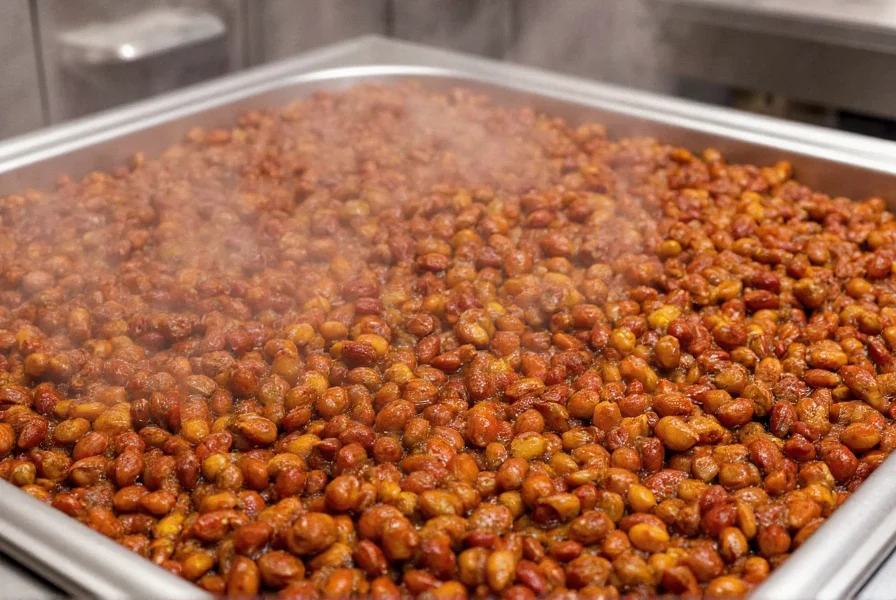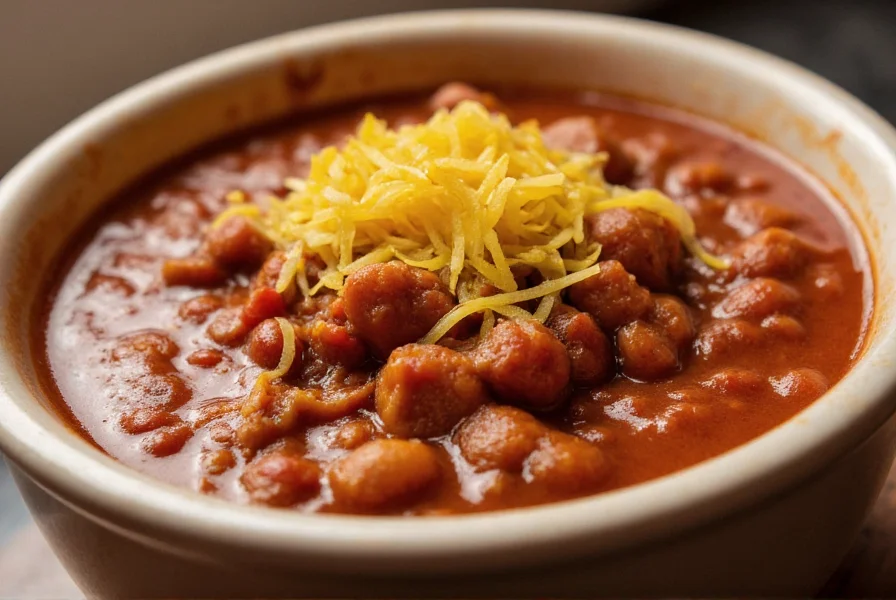When you encounter chili in a school or workplace cafeteria, you're experiencing a carefully engineered food product designed to satisfy diverse palates while meeting strict operational requirements. This distinctive style of chili has evolved over decades to balance taste, nutrition, cost, and scalability in institutional settings.
Defining Characteristics of Cafeteria-Style Chili
Cafeteria chili stands apart from other chili varieties through several key features that make it suitable for mass production and service. Understanding these characteristics helps explain why it tastes and feels different from what you might prepare at home.

Consistent Texture and Thickness
Unlike traditional chili which might have varied textures, cafeteria chili maintains a uniform, moderately thick consistency that holds well in steam tables for hours. Food service professionals achieve this through precise ratios of meat, beans, and thickening agents like cornstarch or commercial gravy mixes. This consistency prevents separation and ensures each serving looks identical.
Standardized Flavor Profile
Cafeteria chili features a deliberately mild, crowd-pleasing flavor profile that avoids extreme heat or complex spice notes. The seasoning blend typically includes:
| Common Seasoning Components | Purpose | Typical Proportion |
|---|---|---|
| Chili powder | Base flavor | 2-3% |
| Garlic powder | Aromatic enhancement | 0.5-1% |
| Onion powder | Sweetness and depth | 0.5-1% |
| Cumin | Earthy notes | 0.3-0.7% |
| Cayenne pepper | Controlled heat | 0.1-0.3% |
Ingredient Composition
The ingredient formula for cafeteria chili follows strict guidelines to ensure cost efficiency and nutritional compliance:
- Protein source: Primarily 80-85% lean ground beef, sometimes supplemented with textured vegetable protein to reduce costs
- Beans: Canned kidney beans (predominantly dark red) for consistent texture and color
- Liquid base: Combination of tomato sauce, diced tomatoes, and beef broth
- Vegetable content: Limited to onions and sometimes bell peppers, finely diced for uniform distribution
- Thickening agents: Cornstarch, commercial gravy mix, or masa harina for stability during service
Historical Development of Institutional Chili
Cafeteria chili emerged in the mid-20th century as schools and institutions sought affordable, protein-rich meal options that could be served efficiently to large groups. The National School Lunch Program, established in 1946, created demand for standardized recipes that met nutritional requirements while staying within tight budgets.
By the 1970s, chili had become a staple in many school lunch rotations due to its versatility, shelf stability of ingredients, and ability to incorporate government-commodity foods. Food service directors refined recipes to ensure consistent results across multiple locations and extended service periods.
Preparation Process for Large-Scale Production
The preparation of cafeteria chili follows a precise methodology designed for institutional kitchen equipment and staffing constraints:
- Batch cooking: Prepared in 20-50 gallon batches using tilt kettles or steam-jacketed kettles
- Meat browning: Ground beef cooked in large batches with minimal fat drainage to retain flavor
- Controlled simmering: Minimum 2-hour simmer to develop flavors while meeting food safety requirements
- Temperature management: Held at 140°F minimum during service to prevent bacterial growth
- Reheating protocols: Strict guidelines for reheating leftovers to maintain quality

Nutritional Profile and Modifications
Modern cafeteria chili must comply with increasingly stringent nutritional guidelines while maintaining acceptable taste. Most institutional versions now feature:
- Reduced sodium content (typically 450-600mg per serving)
- Increased whole grain content through bean varieties
- Leaner meat options or plant-based protein alternatives
- Added vegetable content to meet new school meal requirements
- Calorie-controlled portions (usually 250-350 calories per standard serving)
Many school districts have reformulated their cafeteria chili recipes to meet the USDA's updated school meal standards, which require increased vegetable variety and reduced sodium levels. These changes have led to more complex flavor profiles while maintaining the essential characteristics that define cafeteria-style chili.
Quality Assessment: What Makes Good Cafeteria Chili?
Despite its simplified nature, well-prepared cafeteria chili should exhibit certain quality markers:
- Visual appeal: Rich, consistent color without separation or excessive grease
- Aroma: Pleasant, mildly spicy scent without burnt or metallic notes
- Mouthfeel: Substantial but not overly thick, with discernible meat and bean textures
- Flavor balance: Harmonious blend of savory, slightly sweet, and mildly spicy notes
- Temperature: Served hot (minimum 140°F) to enhance flavor perception
Poor quality cafeteria chili often displays separation of liquids, inconsistent texture, overly metallic taste from canned ingredients, or an unbalanced flavor profile dominated by a single spice element.
How Cafeteria Chili Differs From Other Styles
Understanding the distinctions between cafeteria chili and other preparations helps explain its unique characteristics:
- Homemade chili: Features more complex spice blends, varied meat cuts, and longer cooking times for deeper flavor development
- Texas-style chili: Contains no beans, uses coarsely chopped beef, and has a thinner consistency
- Cincinnati chili: Served over spaghetti with unique Mediterranean spice profile including cinnamon and cocoa
- Restaurant chili: Often includes premium ingredients and more complex layering of flavors
Cafeteria chili's simplified formula represents a practical adaptation of traditional chili for environments where consistency, cost control, and efficient service take precedence over culinary complexity.
Frequently Asked Questions
What makes cafeteria chili different from regular chili?
Cafeteria chili differs from regular chili through its simplified recipe, standardized texture, and mild flavor profile designed for mass production. It typically uses ground beef rather than stew meat, includes kidney beans as a standard ingredient, and features a consistent thickness that holds well in steam tables. The spice blend is deliberately mild to appeal to broad audiences, and the recipe is engineered for cost efficiency and nutritional compliance in institutional settings.
Why does cafeteria chili taste different than homemade chili?
Cafeteria chili tastes different than homemade chili primarily due to its standardized recipe designed for large-scale production. Institutional kitchens use precise ingredient ratios, commercial seasoning blends, and specific cooking equipment that create a consistent but less complex flavor profile. The need to hold chili at serving temperature for extended periods also affects flavor development compared to freshly made homemade versions that benefit from longer simmering and resting times.
What are the main ingredients in school cafeteria chili?
School cafeteria chili typically contains ground beef (80-85% lean), canned kidney beans, tomato sauce or diced tomatoes, onions, and a standardized spice blend featuring chili powder, garlic powder, onion powder, cumin, and minimal cayenne. Many modern versions also include texturized vegetable protein to reduce costs and increase protein content while meeting nutritional guidelines for school meals.
Is cafeteria chili healthy for school lunches?
Modern cafeteria chili can be a nutritious option for school lunches when properly formulated. It provides protein from beef and beans, fiber from beans and tomatoes, and can be adapted to meet current nutritional standards with reduced sodium, increased vegetable content, and leaner meat options. Most school versions contain 250-350 calories per serving with 12-18 grams of protein, making it a balanced meal component when served with appropriate side dishes.











 浙公网安备
33010002000092号
浙公网安备
33010002000092号 浙B2-20120091-4
浙B2-20120091-4